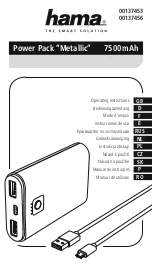
www.pulsar.pl
PSBEN2012B/LCD
BLACK POWER
7
3.3
Description of PSU’s components and connectors.
Table 1. Elements of the PSU pcb (see Fig. 2).
Element no
Description
PANEL
– optical indication connector
P
BAT
– jumper; idle in this model
T
AC
– jumpers J1, J2; idle in this model
CAUTION. In this model, jumpers are operated from the LCD desktop’s level (see: chapter. 6.2).
I
BAT
– pin
;
battery charging current selection
J1=
, J2=
J3=
I
BAT
=0,2 A
J1=
, J2=
J3=
I
BAT
=0,6 A
J1=
, J2=
J3=
I
BAT
=1,0 A
J1=
, J2=
, J3=
I
BAT
=1,5 A
Caption:
jumper on,
jumper off
START
–
button (launching the PSU from a battery)
STOP
–
button (disconnection of the PSU during battery-assisted operation)
– pin; activation of the acoustic indication
- indication on
- indication off
Caption:
jumper on,
jumper off
V
ADJ
–
potentiometer,
DC voltage adjustment
BUZZER
–
acoustic indicator
F
BAT
–
fuse in the battery circuit
Connectors:
~AC~
– AC power input
+BAT
–
DC power battery output
+AUX
– DC power output (+AUX= +U, -AUX=GND)
EPS FLT
– technical output of AC network absence indication
open
= AC power failure
close = AC power - O.K.
PSU FLT
– technical output of PSU failure
open
= failure
close = PSU working correctly - O.K.
APS FLT
– technical output of battery failure
open
= battery failure
close
= battery O.K.
EXT IN
– output of collective failure
V
EXT
pin
– polarization of EXT IN circuit
Communication connector
LEDs
– optical indication:
AC
– presence of the AC power
AUX
–
DC output voltage
OVL
–
PSU overload
PSU
–
PSU failure
APS
–
battery failure
EXT
– EXT IN output’s status
LB
– battery charge
OVP
–
optical indication for activating the over voltage system
TAMPER
– connector for the micro switch tamper








































